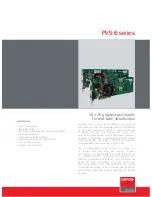
© National Instruments
|
2-3
Chassis Ambient Temperature Definition
The chassis fan control system uses intake air temperature as the input for controlling fan speeds
when in Auto Fan Speed mode. Because of this, the chassis ambient temperature is defined as
the temperature that exists just outside of the fan intake vent on the bottom of the chassis. Note
that this temperature may be higher than ambient room temperature depending on the
surrounding equipment and/or blockages present. It is the user’s responsibility to ensure that this
ambient temperature does not exceed the rated ambient temperature as stated in the
PXIe-1073
Specifications
on
Setting Fan Speed
The AUTO/HIGH fan-speed selector switch is on the rear panel of the PXIe-1073. Refer to
Figure 1-2,
Rear View of the PXIe-1073 Chassis
, to locate the fan-speed selector switch. Select
HIGH for maximum cooling performance (recommended) or AUTO for quieter operation.
When set to AUTO, the fan speed is determined by chassis intake air temperature.
Installing Filler Panels
To improve module cooling performance, install filler panels (provided with the chassis) in
unused or empty slots. Secure with the captive mounting screws provided.
Installing Slot Blockers
The cooling performance of the chassis can be improved by installing optional slot blockers.
Refer to
ni.com
for more details.
Rack Mounting
Rack mount applications require the optional rack mount kits available from National
Instruments. Refer to he
PXIe-1073 Specifications
and the instructions supplied with
the rack mount kits to install your chassis in an instrument rack.
Note
You may want to remove the feet from the chassis when rack mounting. To
do so, remove the screws holding the feet in place.
Connecting Safety Ground
Caution
The PXIe-1073 chassis is designed with a three-position inlet that
connects the cord set ground line to the chassis ground. To minimize shock hazard,
make sure the electrical power outlet you use to power the chassis has an appropriate
earth safety ground.
















































